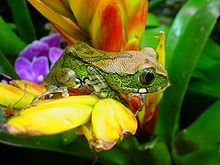Tree frog
Tree frogs are frogs that spend most of their life in trees.



There are several lines of Neobatrachia which have evolved into tree frogs. These groups are only distantly related, but they have evolved for a long time in similar conditions. The result is that now there are species from different groups which look very much like each other. This is convergent evolution. It goes so far that in almost all cases, where one group occurs, another does not. Their current distribution shows that the last common ancestor of the groups lived before the dinosaurs disappeared.
The frogs do not normally come down to the ground, except to mate and spawn. Some build foam nests on leaves and rarely leave the trees as adults. In some species the eggs develop directly into adults; in others the tadpole stage is spent in the water pool of a large tropical tree leaf.
Many tree frogs can change their colour for better camouflage. Others are poisonous (poison dart frog), and display warning colouration.
Tree frogs are usually tiny, as their weight has to be carried by the branches and twigs of their habitat. While some reach 10 cm (4 in) or more, they are typically smaller and more slender than terrestrial frogs.
Typical for "tree frogs" are well-developed discs on the finger and toe tips. The fingers and toes and the limbs tend to be rather long. This gives better grasping ability. The genus Chiromantis is most extreme in this respect: it can oppose two fingers to the other two, resulting in a vice-like grip.
Family
changeTree frogs are members of these families or genera:
- Hylidae, or "true" tree frogs, are in the temperate to tropical parts of Eurasia north of the Himalayas, Australia and the Americas.
- Rhacophoridae, or shrub frogs, are the tree frogs of tropical regions around the Indian Ocean: Africa, South Asia and Southeast Asia east to Lydekker's line.[2] A few are in East Asia.
- Centrolenidae, or glass frogs, are potentially closely related to hylids; these translucent frogs are native to Central and South America.
- Hyperoliidae, or reed frogs, are closely related to the burrowing Microhylidae; these small frogs are native to sub-Saharan Africa.
- Boophis is a genus of highly arboreal frogs which evolved from the toxic terrestrial Mantellidae of Madagascar.
- Pedostibes, or tree toad, is a genus of highly arboreal members of the typically terrestrial Bufonidae.
References
change- ↑ "Rare frog dies, one of only two left in the world". WKYT News. 2012-02-17. Archived from the original on 2013-10-04. Retrieved 2012-02-17.
- ↑ Lydekker's line runs to the east of Wallace's line, but still west of New Guinea and Australia.